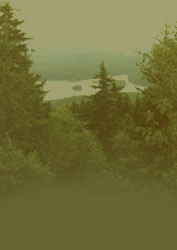|
Do you have something
happening in your corner of Washington? - Please call a member
or e-mail your observations to have them included here
November:
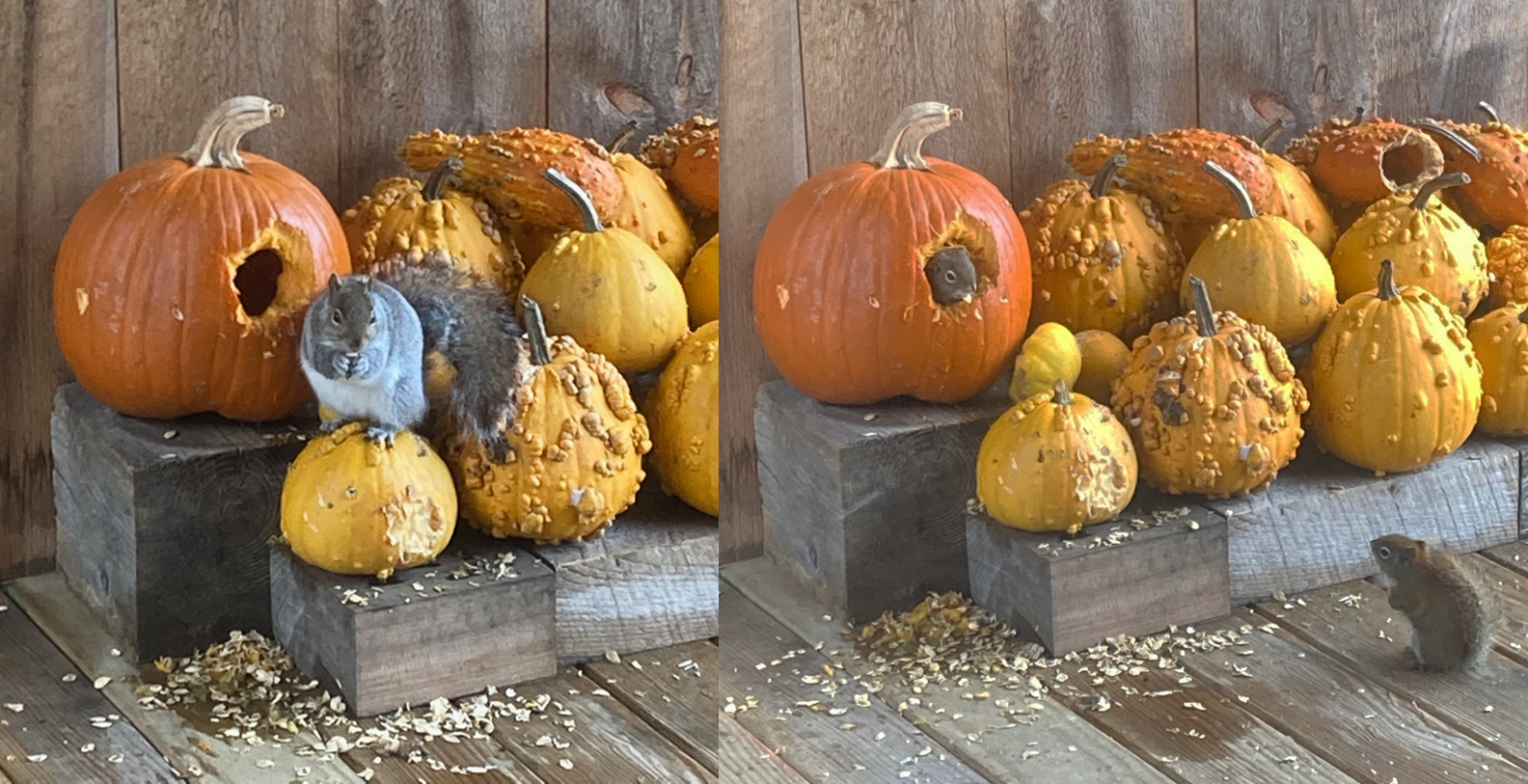
Pictures by Cody Nowell, grey squirrel made the hole and red squirrels moved in to feast
Jed shared a video from Cody showing squirrels eating a hole in a pumpkin to get to the seeds inside. Nan said squirrels have done that to all the pumpkins they had sitting outside, including their carved jack-o-lanterns. They would find a pile of pumpkin flesh and a hole in the pumpkin with a trail of guts and seeds dragged out through the hole. It is behavior they haven’t seen before with squirrels but it turns out it is not that unusual!
This year was not a good year for mast production. Mast is the term for the fruit of beech, oak, chestnut, and other forest trees, which is a great source of food for wild animals including squirrels. Oak trees especially weren't putting out nearly as many acorns as they usually do, causing the squirrels to find other sources of food. Pumpkins do offer some big tasty seeds and yummy stringy guts that squirrels will happily eat.
Squirrels aren’t the only ones that enjoy a pumpkin snack; chipmunks, birds, and even deer have been known to chomp down on these fruits!
They eat them because instinct tells them they need to fatten up for the winter. If you give them tastier fare; peanuts, sunflower seeds, stale bread, crackers, they'll have their fill without spilling pumpkin guts all over the yard.
September:
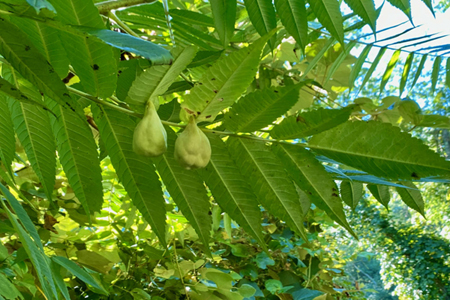
Sumac Gall Photo found at Seashore to Forest Floor
Arin heard some noise in her Staghorn Sumac and noticed a Red Squirrel eating something. On closer examination she noticed tons of galls on her plants. Sumac leaf galls are caused by an aphid called the sumac leaf gall aphid, Melaphis rhois, these galls are largely inconsequential to plant health, but are an interesting biological curiosity.
The sumac plant is triggered to produce the gall when a female aphid lays a single egg on the underside of the leaf. To cordon off the intruder, the leaf then forms a large sac around the egg.
The sumac gall aphid has a complex life cycle, called alternation of generations, where summer generations are produced within galls on the sumac plant, while winter generations are produced within colonies of moss beneath or near the sumac. The initial gall-producing egg laid on the sumac leaf will result in a single female aphid. This female then reproduces asexually within the gall, through a process called parthenogenesis, creating enough clones of herself to fill the gall. If the gall “matures” without be predated, these cloned females will be released at the end of the summer or early fall and drop onto mosses below where they will pass the winter, establishing asexually reproducing colonies. Ultimately, these moss-dwelling aphid colonies produce the males and sexual females responsible for recolonizing sumac each spring, restarting the cycle. Just another example of how complex and interwoven everything in the environment is.
It is hard to say why the Red Squirrel was eating the galls but he may have been after the honeydew that the aphids produce inside the gall (it is sweet!) or he may have been eating the aphids themselves.
This information found at Seashore to Forest Floor
August:
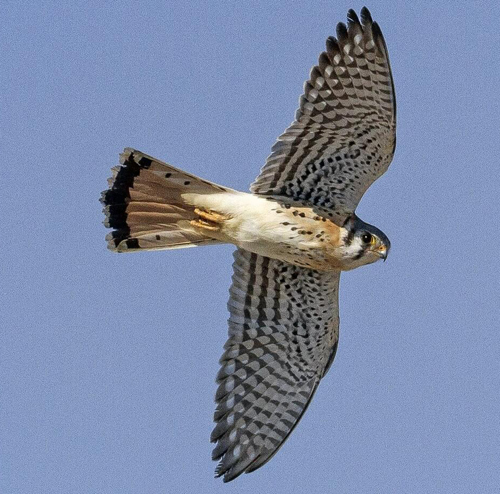
Photo by Jacob Drucker, found at Cornell Lab of Ornithology Macaulay Library
Jed thinks he saw a Kestrel flying around but he was not sure if it was. The Kestrel is a small falcon. Arin said that there is a great free app you can use to ID birds by their song or call or by a picture of the bird, that she recommended. It is called Merlin Bird ID and developed by the Cornell Lab of Ornithology.
“Bird Packs” are available and they provide a field guide to the birds of the region you are in. If you are visiting a different area you can download a pack for that region.
“Sound ID” listens to the birds around you and shows real-time suggestions for who’s singing. It can identify multiple birds from one recording. Compare your recording to the songs and calls in Merlin to confirm what you heard.
Snap a photo of a bird, or pull one in from your camera roll, and “Photo ID” will offer a short list of possible matches. Photo ID works completely offline, so you can identify birds in the photos you take no matter where you are.
With “Bird ID Wizard” Merlin asks you to describe the color, size, and behavior of the bird you saw to aid in identification if you didn’t get a sound recording or a photo to ID.
You can save birds you have seen to your “Life List” and also explore lists of birds near you at different times of year.
Download the app and give it a try if you have ever wondered “What is that Bird?”
Get the app here:
Cornell Lab of Ornithology, Merlin
July:

Photo by NWSGray, USFWS, found at National Weather Service
Extreme heat can be dangerous. Across the country, the Centers for Disease Control and Prevention says more than 600 people die annually from extreme heat. In New Hampshire, the Granite State News Collaborative found that more than 1,400 residents went to the ER for heat-related illness between 2012 and 2019.
Heat can have harmful effects on anyone, but some people are at even greater risk. According to the CDC, that includes older adults, young children, people with chronic medical conditions, low-income populations, athletes and people who work outdoors. Heat can also be especially dangerous to pregnant people.
Dizziness, nausea, hot skin and a rapid pulse are some of the signs of heat stroke. Heavy sweating, fainting, dizziness and headaches are some symptoms of heat exhaustion.
To stay safe during a heat wave, New Hampshire emergency preparedness officials advise avoiding the outdoors and sun exposure as much as possible, limiting outdoor work and sun exposure during the hottest parts of the day, and wearing loose-fitting and lightweight clothing. If you must stay inside and don’t have access to air conditioning, they also recommend staying on lower floors because heat rises.
New Hampshire Homeland Security and Emergency Management Director Jennifer Harper encourages people to stay hydrated and drink lots of water — even if you’re not thirsty.
Harper also urges people to avoid leaving children or pets unattended in closed vehicles, and to “check on family, friends, and neighbors who do not have air conditioning and who spend much of their time alone.”
This information found at NHPR
June:
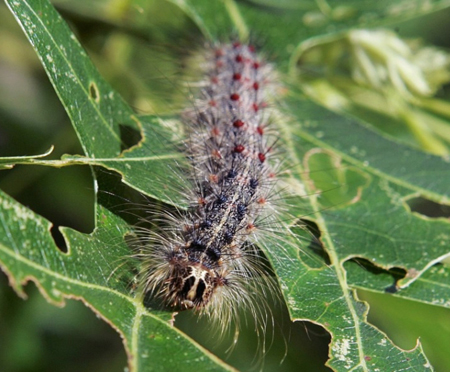
Caterpillar Photo by James Appleby, USFWS, found at Forest Society
Spongy moth (Lymantria dispar dispar), formerly known as the gypsy moth, is an important defoliating insect of hardwoods in New Hampshire. A native of Europe and Asia (though we don't think we have the Asian varieties), spongy moth was introduced into North America in 1869 when specimens were accidentally released in Medford, Massachusetts. Spongy moth is an outbreak pest and can remain at low levels for several years and then numbers can rise every few years. Many might remember the outbreaks in the early 1980s and 1990s. Unless areas are actively monitored, even moderate spongy moth populations can exist unnoticed. Although these cycles are influenced by numerous factors, the low populations in New Hampshire in recent years generally are believed to be the result, at least in part, of a spongy moth disease caused by the fungus Entomophaga maimaiga.
The caterpillars prefer oaks, apples, birches, poplars, and willows. Less preferred species are ashes, maples, cherries, elms, beeches, and softwoods. Caterpillars will feed on many kinds of plants once the preferred trees in an area or stand are defoliated.
The female moth deposits her egg mass of 300-500 eggs in July- August. The eggs overwinter on trees, rocks, stumps, in crevices, and on buildings. The eggs hatch in May and tiny larvae (caterpillars) spin fine silken threads which help them wind-disperse.
The larvae mainly feed at night and crawl down trees to seek shade during the day. They feed until late-June or early-July and pupate. In 10-14 days, adult moths emerge from the pupal stage. The male moths fly to the flightless females, usually on tree trunks, and mate. The females deposit egg masses shortly after mating. There is only one generation per year.
After several years of defoliation, the population collapses, usually due to a viral disease. It will then remain at low levels until populations build and erupt again. In New Hampshire, outbreaks have occurred on average every 7 to 10 years since 1924. Nowadays, the outbreaks are more localized than widespread.
Recent outbreaks of spongy moth in southern New England and some small populations in a few southern New Hampshire towns are worrisome. Forest health specialists are monitoring the situation.
This information found at NH Bugs
and UNH Resources
May:
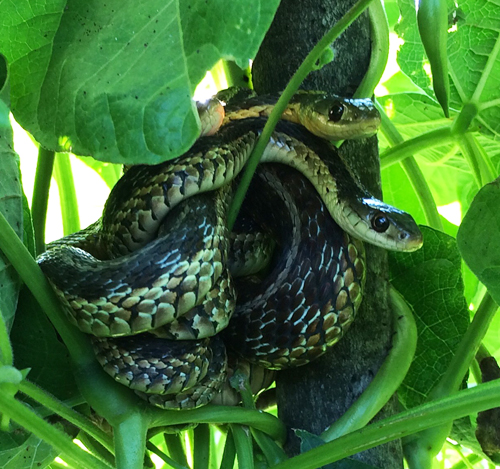
Snake Photo - Jed Schwartz
Snakes are now out and about in the warm weather and you may be fortunate enough to see one.
There are 11 species of snakes that are native to New Hampshire (see the list below). Some of these species, such as the garter snake are common and widespread across the state. Other species like the timber rattlesnake are extremely rare and are now state protected.
Five of the 11 species (i.e., timber rattlesnake (state endangered), eastern hognose snake (state endangered) , northern black racer (state threatened), smooth green snake, and ribbon snake) were identified as species in greatest need of conservation in New Hampshire’s Wildlife Action Plan completed in the fall of 2005.
Overall, snakes are poorly studied and basic distribution and life history information is lacking. The New Hampshire Fish & Game maintains a database of all reptile and amphibian reports through its Reptile and Amphibian Reporting Program (RAARP).
The first step to reporting a sighting is accurately identifying the species. Information and photographs were compiled for all of New Hampshire’s native snakes to aid in this identification process. Click on the links below to see pictures and get information on each native snake species.
• Garter snake (Thamnophis sirtalis)
• Ribbon snake (Thamnophis sauritus)
• Brown snake (Storeria dekayi dekayi)
• Northern red-bellied snake (Storeria occipitomaculata occipitomaculata)
• Ringneck snake (Diadophis punctatus edwardsii)
• Smooth green snake (Opheodrys vernalis)
• Milk snake (Lampropeltis triangulum triangulum)
• Eastern hognose snake (Heterodon platirhinos) – State Endangered
• Northern black racer (Coluber constrictor constrictor) - State Threatened
• Northern water snake (Nerodia sipedon sipedon)
• Timber rattlesnake (Crotalus horridus) – State Endangered
PLEASE DO NOT KILL SNAKES! New Hampshire has only one venomous snake, the timber rattlesnake, which is protected by law. If you think you see a timber rattlesnake, please leave it alone, and let Fish & Gane know. There is no reason to kill a New Hampshire snake.
This information found at NH Fish and Game
April:
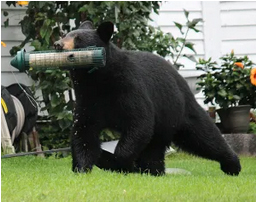
Bear Photo found at NH Fish & Game
Arin’s bird feeder was taken down by a big black bear recently! Our local bears are now active, having finished their winter hibernation, and they are hungry. Nothing looks better to a hungry bear than a bird feeder full of seeds.
NH Fish and Game recommends that you take your bird feeders down no later than April 1st or earlier if we have a mild winter or early spring. Bears attracted to bird feeders can become accustomed to humans and this may lead to conflicts.
Another good reason to take down you feeder is that they attract squirrels, chipmunks, rats, mice and voles. They are inclined to nest near consistent source of food so taking feeders down can discourage their presence. These rodents often carry ticks, chew, burrow, damage trees and crops, and invade attics, basements and barns.
The birds you have been watching at your feeder will be able to find plenty of insects and seeds on their own in the wild so you don’t need to worry about their well-being after taking down your feeders. They benefit most from the supplemental food in the harshest winter weather if you put your feeders back up on December 1st.
This information found at UNH Extension - Question of the Week
March:
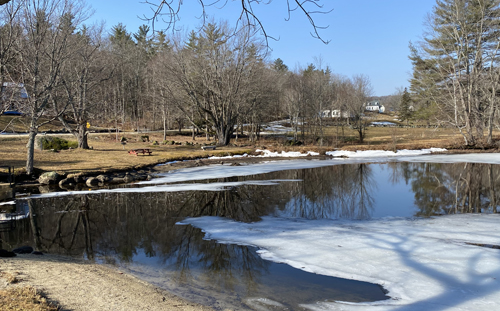
Photo by Jed Schwartz
Jed mentioned that there is a lot of open water in Mill Pond already. ”Ice-out" is the term typically used to describe when the ice leaves a lake in the spring. Some consider this to be when the ice has melted and broken up enough to navigate a boat from one end of a lake or pond to the other, or when the lake is completely free of ice. Although ice-out definitions may vary slightly from lake to lake, the important thing is consistency and utilizing the same method to determine ice-out for your lake each year. "Ice-in" is the term used to describe when ice covers a lake in the fall. Ice-in can be more difficult to determine but typically is when the lake is completely or nearly completely covered with ice, however a thin skim of ice is not considered ice-in.
NHDES Volunteer Lake Assessment Program (VLAP) began tracking lake ice-in and ice-out dates in 2011 as there was no central repository for this information in New Hampshire. Tracking both ice-in and ice-out allows the determination of total ice cover days which is another important part of tracking physical, chemical and biological changes to lakes over time. With the erratic weather conditions experienced in recent years, the information can also help track climatological shifts and trends.
Ice-out is a big deal on the biggest lake in the state, Lake Winnipesaukee! They even have guessing contests. ”Ice-Out" on Lake Winnipesaukee is the moment when the ice that has covered the Lake since late December or early January melts enough that the M/S Mount Washington cruise ship could navigate between its ports in Alton Bay, Center Harbor, Weirs Beach, Meredith and Wolfeboro.
Ice-Out is anxiously awaitied by residents and visitors since it is the traditional start of the spring season and many Islanders regain water access to their cottages. The date has been observed and recorded for over 135 years. The setting of the exact date and time is non-scientific and is now determined by an observer in a small plane from Emerson Aviation that flies over the lake several times a day. When the pilot makes the Ice-Out call it is considered official! Last year it was April 5th, what will it be this year?
This information found at NH VLAP Program and Ice Out on Winnipesaukee
February:
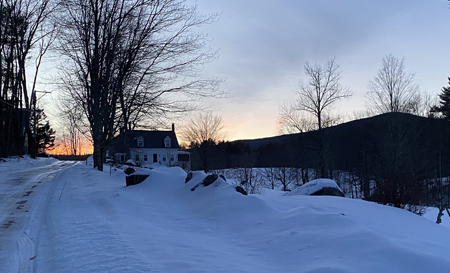
Photo by Jed Schwartz
After the winter solstice on December 21st, which marks the shortest day of the year, the days start to get longer. Noting the longer days made us wonder when spring will finally be here.
With the “spring forward” clock change to Day Light Savings time on March 13th we will be seeing later sunsets and longer days. Spring officially arrives on March 20th with the Spring or Vernal Equinox, when day and night are of equal length and the sun sits exactly above the equator. There will be a full “Super Moon” that will coincide with equinox this year.
Spring in New Hampshire is one of fits and starts. The snow keeps coming (and going), the maple sap is flowing and mud season is here one day and the roads are frozen up again the next. One day can be full on winter and the next can be sunny and warm causing the brooks to flow with snow melt.
It is a great time to get outside. Go spring skiing, take a walk or hike (be prepared for muddy roads) or go visit a local sugar shack to watch maple sap being boiled into syrup. Start a few seeds on the window sill to remind yourself that the growing season will be here soon. Nature is starting to awaken and the signs are all around us. It’s going to be a while longer before the winter totally loses it grip on us but spring is on its way!
This information found at Old Farmers Almanac
January:
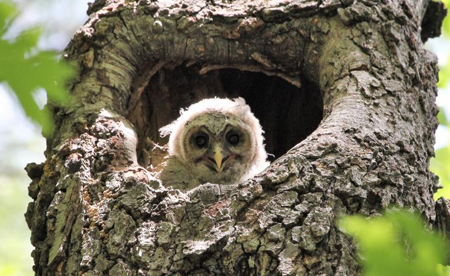
Owlet Photo by Anne Marie Warren Old Farmers Almanac
Arin saw 2 owls fly across the road together near the transfer station and wondered what they were up to.
Both the Barred Owl and the Great Horned Owl are well into their domestic duties by January. Males generally find a territory by December and a nesting site by January. Despite the cold, eggs are laid at the end of January through February, as this gives the large bird’s chicks enough time to develop before spring arrives.
Keep in mind: When owls are nesting, they’re very territorial. If an owl swoops down near you, they’re just focused on mating and nesting—and will chase away intruders while hooting loudly.
Both species tend not to build their own nests. Instead, they will spruce up an old nest made by another animal. Nests are lined with bark, feathers, animal fur, and leaves, but by the end of the nesting season, the nest deteriorates to a few sticks.
• The Great Horned Owl uses tree nests of other birds such as hawks, crows, squirrels, and Great Blue Herons, but will also use tree cavities, snags of broken trees and wood platforms, and occasionally a building or barn. The most commonly used nest is that of the Red-tailed Hawk.
• Barred Owls often use natural cavities in trees, about 20 to 40 feet high. They may also use stick platform nests built by other animals (including hawks, crows, ravens, and squirrels), as well as human-made nest boxes.
For both owls, 2 to 3 eggs are laid 2 to 4 days apart. Females can incubate eggs in temperatures as low as -35°F and eggs have been known to survive at -25°F for up to 20 minutes while the female takes a break from incubation duties!
The eggs hatch in about 33 days. The female incubates the eggs while the male brings food to her at the nest. In the case of the Great Horned Owl, skunk is a favorite food, so it is not unusual to smell the scent of a skunk at this time of year near a nest. Mice and smaller birds are preferred by the Barred Owl.
The owls have thick feathers to keep the young warm. Even their legs and feet are feathered! Plus, the young hatch with a layer of fluffy down to keep them warm. Early nesting might give the young time to learn hunting skills before the next winter. In years of low mouse or squirrel populations, however, many eggs do not hatch and many young do not survive.
This information and more found at Old Farmers Almanac
To view yearly archives of our "New In
Nature" series click on year you wish to see.
2002
2003
2004
2005
2006
2007
2008
2009
2010
2011
2012
2013
2014
2015
2016
2017
2018
2019
2020
2021
|


